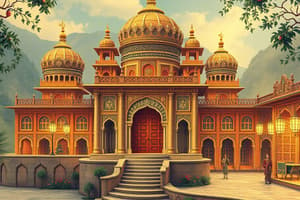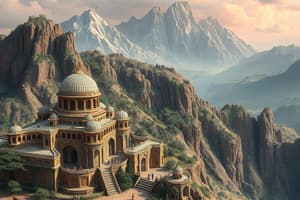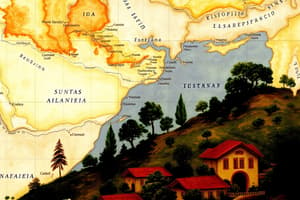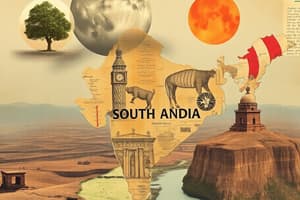Podcast
Questions and Answers
The Indus and Ganges Rivers meet to form a delta at the Bay of Bengal.
The Indus and Ganges Rivers meet to form a delta at the Bay of Bengal.
False (B)
Which of the following characterizes the climate of South Asia?
Which of the following characterizes the climate of South Asia?
- Arctic
- Desert
- Temperate
- Tropical (correct)
What mountain range separates the Indian subcontinent from the Tibetan Plateau?
What mountain range separates the Indian subcontinent from the Tibetan Plateau?
Himalayan Mountain Range
The chain of mountains in the far north of the Indian subcontinent includes the __________.
The chain of mountains in the far north of the Indian subcontinent includes the __________.
Which river flows from the Himalayas through India to the Arabian Sea?
Which river flows from the Himalayas through India to the Arabian Sea?
Match the following mountain ranges with their descriptions:
Match the following mountain ranges with their descriptions:
Maldives is a teardrop-shaped island that broke off the Indian landmass.
Maldives is a teardrop-shaped island that broke off the Indian landmass.
A scientific term for rainfall is __________.
A scientific term for rainfall is __________.
Which mountain range stretches between central Afghanistan and Northern Pakistan?
Which mountain range stretches between central Afghanistan and Northern Pakistan?
Nepal’s abundant timber resources are threatened by overcutting of forests.
Nepal’s abundant timber resources are threatened by overcutting of forests.
What are the three major rivers of northern South Asia?
What are the three major rivers of northern South Asia?
The Ganges Plain of India is home to one-tenth of the world's ______.
The Ganges Plain of India is home to one-tenth of the world's ______.
Match the following regions with their characteristics:
Match the following regions with their characteristics:
What is the significance of the Khyber Pass?
What is the significance of the Khyber Pass?
India is a major exporter of mica, a mineral used to make electric equipment.
India is a major exporter of mica, a mineral used to make electric equipment.
The winter monsoon winds and the summer monsoon winds blow in ______ directions.
The winter monsoon winds and the summer monsoon winds blow in ______ directions.
What climatic change is experienced when traveling from Northern India to the Tibetan Plateau?
What climatic change is experienced when traveling from Northern India to the Tibetan Plateau?
The Vindhya Mountain range separates the northern and southern regions of the Indian subcontinent.
The Vindhya Mountain range separates the northern and southern regions of the Indian subcontinent.
What type of rock is found on the Deccan Plateau and what is it used for?
What type of rock is found on the Deccan Plateau and what is it used for?
Severe flooding often occurs in Bangladesh during excessive __________ rains.
Severe flooding often occurs in Bangladesh during excessive __________ rains.
Which mountain passes have historically been used by invaders into the region?
Which mountain passes have historically been used by invaders into the region?
Sailboats and merchants utilize the winter and summer monsoon winds that blow in the same direction.
Sailboats and merchants utilize the winter and summer monsoon winds that blow in the same direction.
Match the following features with their corresponding impacts or characteristics:
Match the following features with their corresponding impacts or characteristics:
The __________ are responsible for the warm tropical rains experienced in the Indian subcontinent between April and September.
The __________ are responsible for the warm tropical rains experienced in the Indian subcontinent between April and September.
Flashcards
What is a subcontinent?
What is a subcontinent?
A large landmass separated from a larger continent by geographical features like mountains or water bodies.
Describe South Asia's climate.
Describe South Asia's climate.
Characterized by high temperatures, significant rainfall, and two main seasons: rainy and dry.
How do the Himalayas affect South Asia's climate?
How do the Himalayas affect South Asia's climate?
The Himalayan Mountains block cold winds from the north and influence the direction of monsoon winds.
What mountain range separates South Asia from the rest of Asia?
What mountain range separates South Asia from the rest of Asia?
Signup and view all the flashcards
What are monsoons?
What are monsoons?
Signup and view all the flashcards
What are the drier months in Bangladesh?
What are the drier months in Bangladesh?
Signup and view all the flashcards
What landform dominates Central and Southern India?
What landform dominates Central and Southern India?
Signup and view all the flashcards
Which river originates in the Himalayas and flows to the Arabian Sea?
Which river originates in the Himalayas and flows to the Arabian Sea?
Signup and view all the flashcards
Why is South Asia called a sub-continent?
Why is South Asia called a sub-continent?
Signup and view all the flashcards
What makes the Ganges Plain significant?
What makes the Ganges Plain significant?
Signup and view all the flashcards
What are monsoon winds?
What are monsoon winds?
Signup and view all the flashcards
What is the Deccan Plateau?
What is the Deccan Plateau?
Signup and view all the flashcards
What is India a major exporter of?
What is India a major exporter of?
Signup and view all the flashcards
Which mountain ranges form the Northern border of South Asia?
Which mountain ranges form the Northern border of South Asia?
Signup and view all the flashcards
Why has the Gangetic Plain been cleared?
Why has the Gangetic Plain been cleared?
Signup and view all the flashcards
Why is Sri Lanka significant in terms of graphite?
Why is Sri Lanka significant in terms of graphite?
Signup and view all the flashcards
Climate Change Across the Himalayas
Climate Change Across the Himalayas
Signup and view all the flashcards
Invaders' Routes Through Passes
Invaders' Routes Through Passes
Signup and view all the flashcards
Separating North and South India
Separating North and South India
Signup and view all the flashcards
Deccan Plateau Rock
Deccan Plateau Rock
Signup and view all the flashcards
Ancient Sea Trade Routes
Ancient Sea Trade Routes
Signup and view all the flashcards
Monsoon Winds and Rainfall
Monsoon Winds and Rainfall
Signup and view all the flashcards
Monsoon Impact on Bangladesh
Monsoon Impact on Bangladesh
Signup and view all the flashcards
Monsoon Winds for Sailing
Monsoon Winds for Sailing
Signup and view all the flashcards
Study Notes
South Asia Geography
- South Asia is a subcontinent separated from the rest of Asia by mountains.
- The Ganges Plain is home to a significant portion of the world's population.
- The major rivers of northern South Asia are the Ganges, Brahmaputra, and Indus.
- Sri Lanka is a major producer of graphite, used in pencils.
- The Khyber Pass is a vital trade route.
- The Hindu Kush mountain range runs between Afghanistan and Pakistan.
Subcontinent Geography
- The Indian subcontinent has four major landscapes.
- Mt. Everest lies between Nepal and Tibet.
- The Deccan Plateau relies on seasonal monsoon rains.
- Most Bangladeshi people are subsistence farmers.
- The Deccan Plateau sits between the Eastern and Western Ghats.
Monsoons and Climate
- A monsoon is a seasonal change in wind direction, often bringing hot and wet weather.
- Sri Lanka has limited timber exports since 1977 to protect its forests.
- Summer and winter monsoons have opposite wind directions.
- India is a major mica exporter.
- The Aravalli Mountains separate the North and South of the Indian subcontinent (False).
- Nepal's forests are threatened by over-logging (True).
- The Himalayas, Karakoram, and Hindu Kush form the northern border of South Asia (True).
Additional Geographical Information
- The Gangetic Plains have been largely converted for agriculture.
- The Indus and Ganges Rivers meet at the Bay of Bengal (False).
- The Maldives are a teardrop-shaped island (False).
- High temperatures and rainfall characterize South Asia's climate.
- The Khyber Pass is between Afghanistan and Pakistan.
- Mountains separate South Asia from the rest of Asia (True).
- Winter monsoon winds bring cooler temperatures with little rainfall.
- The Deccan Plateau is the large central plateau of the southern Indian subcontinent.
- The Himalayas, Karakoram, and Hindu Kush Mountains form a significant portion of the northern border of South Asia.
- India is a major exporter of mica used in electrical equipment (True),.
- The Indian subcontinent has highest mountains, is the majority of the world's highest.
- The region's climate is profoundly influenced by monsoons.
- The Deccan Plateau is composed of volcanic rock.
- Ancient sea traders used routes toward the Arabian Gulf and African coasts, and Southeast Asia.
Studying That Suits You
Use AI to generate personalized quizzes and flashcards to suit your learning preferences.




